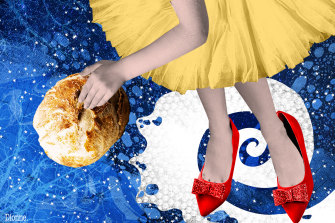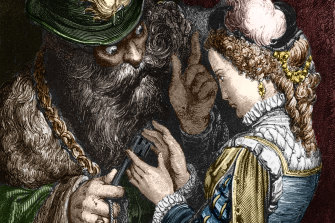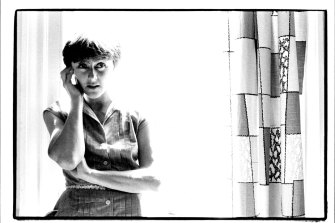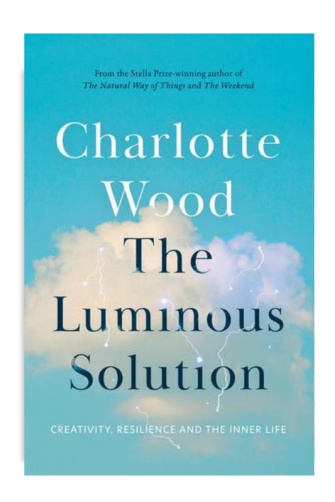By Charlotte Wood
The fairytale I remember most vividly from childhood—or at least I thought I did—is The Girl Who Trod on the Loaf.Credit:Dionne Gain
I had a weird dream last night. Don’t worry, I’m not going to tell you about it. I’ll tell you something else instead, about fairytales. The fairytale I remember most vividly from childhood – or at least I thought I did – is The Girl Who Trod on the Loaf by Hans Christian Andersen. This little-known story concerns a vain and haughty girl who, though very poor, possesses a single pair of exquisite shoes.
In my memory of the tale, the girl’s mother sends her with the family’s last sixpence to buy a loaf of bread – the last food they can expect to eat before they starve. On her way home with the loaf, the girl comes to a puddle. Faced with a choice between muddying her beautiful shoes or the betrayal of her mother and starvation, she chooses the latter, casting the loaf of bread into the puddle to use as a stepping stone. But as soon as her foot touches the loaf the puddle becomes a terrifying vortex, wrenching her bodily through the mud, down, down into a hellish underworld. And that’s where she remains, punished eternally for her vanity.
The fairytale I remember most vividly from childhood—or at least I thought I did—is The Girl Who Trod on the Loaf.Credit:Dionne Gain
When I think of this story, I also think of a recurring nightmare that lasted throughout my childhood. The dream always began with my walking across the road from my real-life house to a neighbour’s letterbox. In the dream, my opening of the letterbox lid was the starter signal for a dread-filled ritual in which I was snatched up by two vast, duelling universes (unending, dark and starry undulations of malevolent power, existing in a time and space far beyond our earth). Each time, I was transformed into a tiny ball that the two universes threw to each other in a game of catch, increasing the distance between them with each toss. The threat – terrifying but also, I knew, somehow magnificent – was twofold: either being destroyed by their malice as they threw and caught me, or being dropped, disappearing into the infinite void between them.
Why have I put these things together, the dream and the story? I was drawn to the pages of that story repeatedly and inexorably, with the same dread-filled compulsion that sent me towards the letterbox in my dream. In both dream and story, there was terror, and the exhilaration of surrendering to that terror. Each contained only a few stark images, but they still glitter in my mind with the same power they always had: white letterbox, starry darkness, silver ball. Red shoes, white bread, black mud. And annihilation.
The dream and the story shared something else, too: an intense privacy of experience, indescribable to anyone else, especially adults. Part of my dream’s force was the invisibility of my terror to anyone else. I was merely a speck, a plaything in a game. Some of that threat – and the exhausting euphoria – always remained with me on waking; perhaps I feared it would leak right out into my conscious life if I spoke of it once morning came. Or, conversely, perhaps I feared it would dissolve into ordinariness if exposed to the light.
When I went back to find and reread the fairytale as an adult, I was surprised by two things: how short is the part in which the bread actually features in the story, and how long and detailed and gruesome is the description of the girl’s penance in hell, where she is forced to become a statue, her feet glued to the bread, and where punishments she visited upon others in life return to torture her. On earth she had pulled the wings off flies, for example; in hell, a captive statue, she is doomed to endure those same wingless flies crawling over her face.
Charlotte Wood (in front of painting by Carly Earl): “I’m one of the nappers, usually when my conscious mind is trying to flee a problem on the page.”
Adults often carry indelible memories of tales they read or were told as children, I’ve found. One friend’s adored favourite story as a girl was Bluebeard. (If you can’t recall or don’t know it, suffice to say it climaxes with a young wife’s discovery of the bloody corpses of her many slaughtered predecessors garlanding the walls of her husband’s locked chamber.) Another friend’s favourite was a story involving a bear whose parents were killed. He remembers nothing else about the story but this, and his desire to experience the horror of it over and over again. None of us remembered the stories’ cheery conclusions. Nor do we recall any parental concern at our gruesome tastes, if indeed they were ever noticed.
An illustration from the classic fairytale Bluebeard by Charles Perrault.Credit:Stefano Bianchetti/Corbis/Getty
I wonder if the fact that we often heard these tales before bedtime helped give them their potency. Perhaps taking those images into our sleep somehow rooted them in the unconscious so deeply they would never fade away.
None of us remembered the stories’ cheery conclusions. Nor do we recall any parental concern at our gruesome tastes.
When we think ‘fairytale’, we tend to think of the most famous ones, with stories that proceed in some logical form. Even if it’s a stretch that a wolf could convincingly masquerade as a grandmother, Little Red Riding Hood has a beginning, a middle, a logical climax and ending. So does Goldilocks and the Three Bears, or Hansel and Gretel. Maybe we know these tales so well because they’re easy to follow and illustrate and so have lasted, passed down through the generations.
But a flick through lesser-known fairytales shows a roiling unpredictability and shapelessness that can only be compared to dreams. The tales of the Brothers Grimm and Hans Christian Andersen are full of absurd and irrelevant phenomena that suddenly appear and disappear – like piles of talking “dead fingers” or squab- bling shovels and brooms – that imprint themselves briefly on the main story and then vanish completely. Many of the stories, such as The Girl Who Trod on the Loaf, linger seemingly forever in strange narrative byways and then abruptly end, without clarity or logical resolution.
The poet Anne Sexton said of writing: ‘To be a fool, that perhaps requires the greatest courage.’Credit:Ian Cook/Getty
All of this, to me, echoes the formlessness of dreaming and sudden waking.
Maybe it’s silly to take dreams as seriously as I do, to be so susceptible to their loose, disconnected, somehow talismanic imagery. Other writers certainly pay a lot of attention to sleep, though. Many observe that when their work is going well they begin to dream about the people and events and scenes of their books. Artists are often insomniacs, as well as frequent nappers, which may or may not be related. Some writers speak of wanting to shrink the space between sleep and work, starting as soon as possible after waking in an attempt to stay in a liminal zone between dreaming and conscious thought. Joan Didion has said that when she’s nearing the end of a book, she needs to “sleep in the same room as it … Somehow the book doesn’t leave you when you’re asleep right next to it.”
Joan Didion (pictured in her apartment in 2005) has said that when she’s nearing the end of a book, she needs to “sleep in the same room as it”.Credit:Judy Griesedieck/Getty
I’m one of the nappers, usually when my conscious mind is trying to flee a problem on the page. I’m often overwhelmed by a kind of narcolepsy, but only on a writing day, and only when I’ve hit some impasse in my work. At those times I give in and fall into a short but deep sleep, waking after 20 or 30 minutes to move straight to the desk, a useful sentence having formed itself in my unconscious mind and now waiting to be written down. This is why I like to have a bed in my writing room if I can, wherever I am. I’ve seen daybeds in plenty of artists’ studios, too, and felt consoled that I’m not alone in using sleep as both escape from and solution to working problems.
I give in and fall into a short but deep sleep, waking to move straight to the desk, a useful sentence having formed itself in my unconscious mind.
Hearing someone else’s dream in its entirety can quickly grow dull, but I’ve sometimes remembered images from other people’s dreams for years. And having a highly vivid dream life myself, I’ve always been irritated by the widely accepted prohibition on dreams in fiction. “Tell a dream, lose a reader,” Henry James is supposed to have said, possibly apocryphally. But when dreaming is such an important part of so many inner lives, it seems odd – even a kind of lie – for fiction to pay it no attention or pretend it doesn’t happen.
I do understand why fictional dreams are frowned upon; we all know how boring and meaningless our dreams are to others, no matter how fascinating they might be to us. But I’m always gratified when a writer breaks this rule, as Helen Garner did in her classic 1977 novel Monkey Grip, which is filled with detailed accounts of narrator Nora’s dreams. Partly I like the simple, truthful mess of them, and Garner’s trust in the reader to take an interest in every meander of Nora’s psyche. It’s consistent with Garner’s trademark willingness to expose the private, unmediated, uncontrolled self – the very thing that has drawn admiring readers to her work for so long. Take that, Henry.
I like the simple, truthful mess of the dreams in the classic novel ’Monkey Grip’by Helen Garner (pictured in 1984).Credit:Ruth Maddison
There is, though, one compelling reason to leave dreams out of fiction, and that is the impossibility of inventing a convincing dream. The conscious mind, or mine at least, can’t help but try to impose some narrative or semi-rational order on the invented dream’s images or events. A made-up dream so often lacks the deep chaos or mystery of a real one, and the result is a ploddingly obvious – and needless – telegraphing of an internal malaise.
We all know how boring and meaningless our dreams are to others, no matter how fascinating they might be to us.
Still, the fact that the images and moods of real dreams can linger in my mind and my body for days or sometimes years convinces me that they’re too important to leave out of books altogether. When it’s done effectively, even a fragment of dream in a novel can offer a flicker of the unknown, the uncanny, signalling that rational thought is not the only realm where meaning can be found.
The Luminous Solution by Charlotte Wood.
If I’m honest, I also find a simple adolescent pleasure in bucking the rules, even if the only one who notices is me. I loathe being told what’s ‘allowed’ or not in art, and even if this defiance of accepted convention doesn’t always work, I always admire the artist who obeys nobody and nothing but herself.
In or outside of books, dreams remind us that no matter how much we pretend otherwise, we’re not in full command of our lives. They remind us that cause and effect are not the solid truths we perceive them to be, that mess and unruliness are always present outside or beneath what’s visible. A remembered dream is a message from the unconscious to say that however much we try, we never really know ourselves at all.
The work of artists is to welcome this unknowing, to allow that the spaces between things—between, say, a dream and a fairytale placed side by side—contain mystery and significance, not just emptiness.
The poet Anne Sexton said of writing: “To be a fool, that perhaps requires the greatest courage.” My dream life shows me every morning that I am a fool, and that a good life in this world requires the courage and the grace to know it. Making art is an attempt to bring into cohesion the fragmented, lost parts of ourselves and our world. And the dream’s mad symbols – its bright letterbox, its tiny silver ball, its shapeless dark – remind me that while any such attempt is surely doomed, it’s still a beautiful thing, to try.
This is an edited extract from The Luminous Solution by Charlotte Wood, published by Allen & Unwin.
The Booklist is a weekly newsletter for book lovers from books editor Jason Steger. Get it delivered every Friday.
Most Viewed in Culture
Source: Read Full Article








